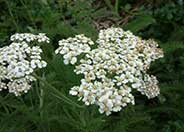
Common name:Sundrops
Botanical name:Calylophus hartwegii
This low-growing perennial grows 1' tall and 3' tall; it has woody stems with bright green leaves. It produces large, lemon yellow flowers that are up to 4" across and bloom spring through summer and possibly through fall, depending on weather conditions.
Maintenance Tips
Calylophus hartwegii is a soft-textured, low-growing perennial with bright yellow flowers. It only grows 12" tall and up to 3' wide. It is very fast growing in the late winter and early spring, and then it is covered with flowers from mid-spring until fall if the weather is ideal. In the fall, when the days start to get shorter and the rains begin, this plant can decline. The root system will stay intact, but the flowering stops, and the foliage will completely die back. This plant benefits from hard pruning, taking the foliage, and branching almost down to the ground. Don't expect any new growth to emerge until the days start to get longer and warm up. The foliage will start to emerge, and the plant's quick growth and blooming cycle will return.
Common name:Pink Gaura
Botanical name:Gaura lindheimeri 'Siskiyou Pink'
Pink Gaura is a profusely flowering perenial that grows to 4' tall. It has pink buds that open to showy pink and white flowers in spring and summer. Accepts full sun or partial shade.

Common name:Silver Mound Artemisia
Botanical name:Artemisia schmidtiana 'Silver Mound'
This mounding perennial will grow 1'-3' high and has medium-sized silvery white leaves with yellow and white flowers.

Common name:Hybrid Tea Rose (selections)
Botanical name:Rosa Hybrid Tea varieties
These shrubs and vines are the most loved in the Western USA and are very resilient. They come in a wide variety of sizes and colors and are easy to maintain with proper care. They can be used in a water-conserving garden with careful attention to irrigation practices.

Common name:Indian Mallow
Botanical name:Abutilon palmeri
Herbaceous shrub with velvety, heart-shaped leaves. Grows quickly to 4'-5' tall and 3' wide. Good for subtropical effect. Plant it next to a patio to enjoy soft texture. Takes full sun or partial shade. Takes reflected heat. May freeze in colder climates. Cup-shaped, apricot-colored blooms on and off during warm months. Arizona Native as well as in low Sonoran Desert in Southern California.
Maintenance Tips
Abutilon palmeri is a fast-growing, California native shrub that has a very dense, but irregular, growth habit. It can get 4-5' tall in one growing season but can continue to grow up to 8' tall and wide if left alone. The majority of the maintenance on this plant is pruning to shape it and keep it in the desired space. One of the best ways to keep the maintenance as low as possible is to give it plenty of room to reach its mature size. If other plants are crowing it out, transplant those other plants further away. This plant can thrive in both full sun and partial shade, but it does not like a wet root system. If it is planted in a shady area, make sure the soil isn’t collecting or retaining moisture. Also, shady areas will result in a taller, rangy plant, so it may require some pruning to encourage lower growth.
Common name:Yarrow
Botanical name:Achillea millefolium
This Achillea features spreading mats of fern-like rosettes, along with deeply divided leaves of a green or gray green color. In this form, the flowers are usually a white tone. Stems can reach 1'-2' above foliage, with flower clusters above foliage. Yarrows propagate easily from rooted cuttings or division, which should be performed in the early spring or fall. Following bloom, one should dead head the plant and divide the clumps when it appears crowded.
Maintenance Tips
Achillea millefolium is a flowering perennial that is often referred to as Yarrow. This native variety can develop a dense matt of foliage 1-2’ tall and 3’ wide with large clusters of flowers that stand another 12” above the foliage. This is an aggressive grower, so the best way to keep it low maintenance is to plant it in full sun, well-drained soil, and give it the space it needs to reach its mature size. Deadheading spent blooms is the key to a long blooming cycle. As the flowers fade, prune them back to the foliage, and new blooms will continue to emerge as long as the weather is warm. When the days are shorter and the wet weather arrives, they will often die back to the ground and go into a short period of dormancy. Pruning out the old foliage that looks mealy will help with airflow and will allow the plant to focus on growing its root system during the winter.
Common name:Ferned-Leaved Tickseed
Botanical name:Bidens ferulifolia 'Goldmarie'
Tickseed grows 14'-18" tall. It is a heat tolerant variety that is perfect for cascading, bright color in baskets, containers, and window boxes. Finely divided foliage is covered with gold, single flowers. It blooms until first frost. Plant in full sun. It needs well-drained soi.

Common name:Fountain Grass
Botanical name:Pennisetum alopecuroides
Pennisetum alopecuroides is a perennial grass. Bright green, 3'-4' tall foliage clumps are topped by pinkish plumes in early summer. Leaves turn yellow in fall and brown in winter. Tall grasses are highly combustible. Note: Not to be confused with Pennisetum setaceum, also known as green fountain grass, which is an invasive species in California. Please do not plant Pennisetum setaceum.
Photographer: GardenSoft
Maintain a two to four inch layer of mulch on the soil surface to reduce weeds, infiltrate rain water, and reduce compaction.
Develop healthy soil for plants that are vigorous and naturally pest-resistant.